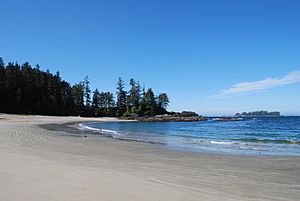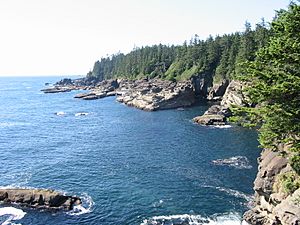Pacific temperate rainforests facts for kids

The Pacific temperate rainforests are the largest temperate rain forest area on Earth. They are found along the western coast of North America. This huge forest stretches from Prince William Sound in Alaska, through British Columbia, all the way to Northern California.
These forests get a lot of rain, sometimes more than 300 centimeters (about 10 feet) each year! The temperatures are mild, usually between 10°C and 24°C (50°F and 75°F). This special climate helps many unique plants and animals thrive.
The trees in these rainforests are mostly conifers. These are trees that have cones and needles, like pine trees. You can also find broadleaf trees, ferns, and shrubs growing there. Some common trees include Sitka spruce, Western hemlock, coast redwood, coast Douglas-fir, western redcedar, and shore pine. Many of the world's tallest trees grow in this region! Trees are often covered in thick epiphytes and mosses.
Hardwood trees like the bigleaf maple and alder are also common. They are important because they help add nutrients to the soil.
Contents
History of the Rainforest
About 200 million years ago, during the time of the dinosaurs, conifers were the main type of trees on Earth. Later, flowering plants appeared and became very common. Most conifers disappeared or had to adapt to harder conditions.
However, the Pacific temperate rainforests are special. Because of their unique climate, conifers still grow very well here, just like they did long ago. These northern rainforests are quite young, forming only a few thousand years ago after the last ice age ended and the huge ice sheets melted away.
Ecology and Forest Zones

These rainforests are incredibly rich in life. They have more living and decaying material (like trees, mosses, and soil) than almost any other ecosystem on the planet! This is partly because fires are very rare here. Instead, small natural events like strong winds or avalanches shape the forest.
The Pacific temperate rainforests stretch across a wide area, from about 40 degrees north to 60 degrees north. This means the climate changes a bit from south to north, creating different forest zones:
- In Northern California, you'll find the "coast redwood zone." These forests are famous for their giant redwood trees.
- From the California/Oregon border up to Vancouver Island, it's the "seasonal rain forest zone." Here, you'll see Douglas fir, western red cedar, Sitka spruce, and Western hemlock.
- North of Vancouver Island, it's the "perhumid rain forest zone." Douglas fir becomes less common, and western red cedar, Sitka spruce, and western hemlock are the main trees.
- Further north, in the Gulf of Alaska, the forest becomes "sub-polar rain forest." Here, the forest is a narrow strip between the ocean and icy mountains. Cedar trees don't grow well here, so Sitka spruce and hemlock are the main trees.
- The very northern parts of the rainforest are found in places like Prince William Sound and Kodiak Island.
Wildlife of the Rainforest
The Pacific temperate rainforests are home to an amazing variety of animals. Scientists exploring the tree tops in the Carmanah Valley found 15,000 new species of invertebrates (animals without backbones)! About 500 of these had never been seen by scientists before.
Many animals here depend on both the forest and the ocean. Salmon are a great example; they lay their eggs in the forest streams but live most of their lives in the ocean. The marbled murrelet is a bird that nests in old trees at night and hunts for food in the ocean during the day.
You might see large bears in these forests. Grizzly bears and black bears live here. Black bears are found throughout the forest, while grizzlies are mostly in Canada and Alaska. These forests have many grizzlies because of the rich salmon streams. The Great Bear Rainforest in Canada is special because it's home to the rare white Kermode bear, also called the "spirit bear."
Other important animals include the bald eagle, marbled murrelet, wolf, and sitka deer. The endangered spotted owl has also been a focus of efforts to protect these forests.
Logging and Conservation
Since the end of World War II, a lot of the Pacific temperate rainforests have been cut down for logging. More than half of the original forest area has been logged. For example, in California, only about 4% of the original redwood forests are still protected. In Oregon and Washington, less than 10% of the original coastal rainforest remains.
The most valuable parts of the forest, like the flat lowlands and valleys where the biggest old trees grow, have been cut down first. Often, protected areas were set up in the mountains, leaving the easier-to-log valleys open to timber companies. This means that even though some large areas are protected, much of the best habitat has already been lost.
In the Tongass National Forest in Alaska, there were long-term agreements that allowed companies to cut down trees. These agreements sometimes meant that trees were sold for very low prices. Many areas of the Tongass National Forest are "roadless," meaning they don't have roads. These areas are very important for wildlife and nature, and there have been ongoing discussions about protecting them from logging. Protecting these forests is important for the many unique plants and animals that call them home.
|


